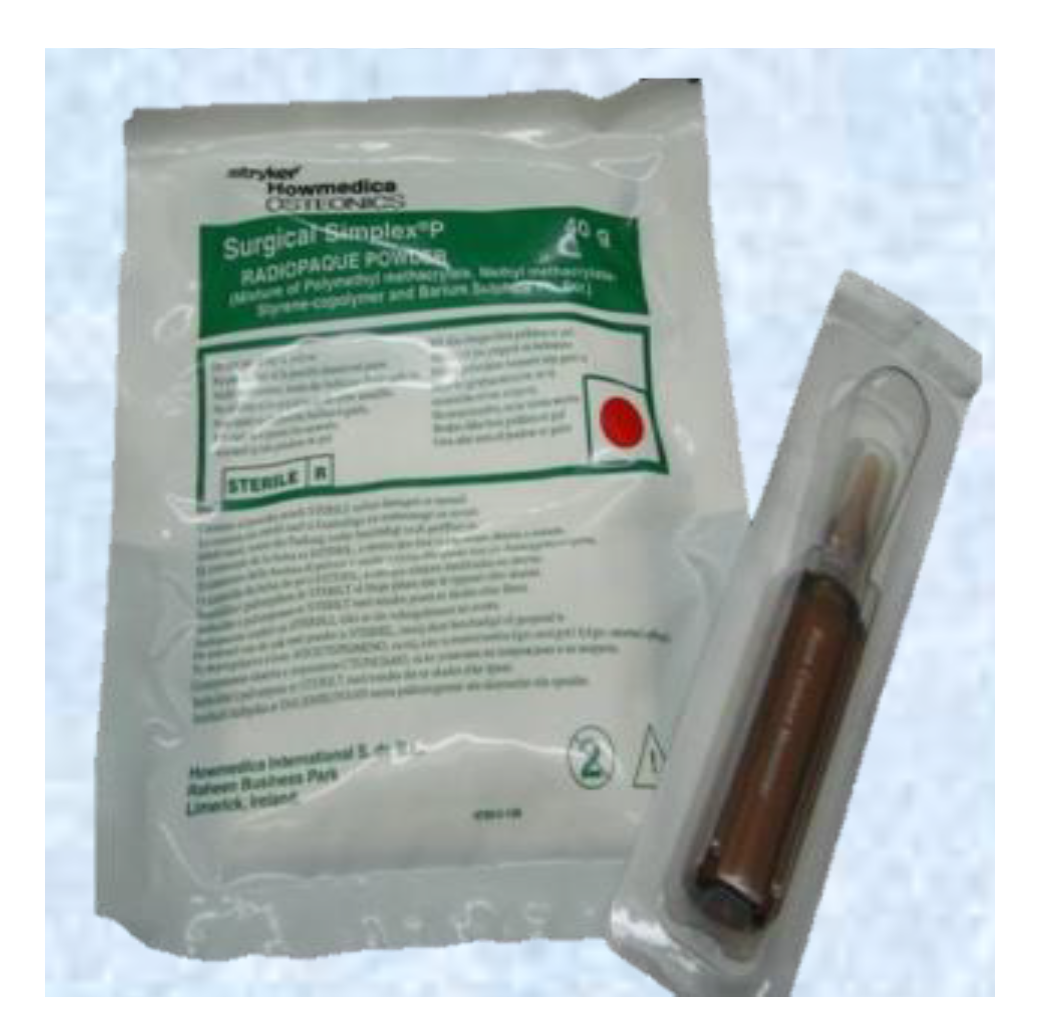Acrylic bone cements (ABC) are widely used in orthopedics for joint fixation, antibiotic release, and bone defect filling, among others. Most of the commercial ABCs available today consist of two components, one solid, based mainly on poly(methyl methacrylate) (PMMA), and one liquid, based on methyl methacrylate (MMA), which are mixed and, through the polymerization reaction of the monomer, transformed into a hardened cement paste.
- Acrylic Bone Cements
- orthopedics
- joint fixation
- bone cement
- PMMA bone cement
1. Introduction
Figure1Figure 3 shows the presentation of Surgical Simplex P commercial cement.

PMMA cements are the most commonly used to bond and load transfer between the implant and the bone [1][2][14,15]. The main advantage of using it is the excellent primary fixation obtained between the implant and the bone and the patient’s faster recovery [3][16]. On the other hand, PMMA is a fragile material with a low resistance to fracture and low fatigue life [4][11].
Commercial ABCs do not differ drastically between brands. The main differences between them are the addition of PMMA copolymers or antibiotics into the solid phase, comonomers to the liquid phase, solid/liquid ratio variation, radiopaque agent variation, or additives chlorophyll Palacos® [4][5][11,17].
The polymerization process begins after mixing of the benzoyl peroxide (BPO) (in the solid) and N,N-Dimethyl-p-Toluidine (DMPT) (in the liquid) with the production of benzoyl radicals at room temperature [6][7][18,19]. The heat produced during polymerization is between 52 and 57 kJ per mole of MMA [8][3]. The maximum temperature reached during the polymerization reaction is known as Tmax [9][20], exceeding 100 °C. These high temperatures can cause cellular bone necrosis and contribute to aseptic loosening [10][11][12][13][10,21,22,23]. Polymerization temperatures experienced under in vivo conditions are much lower (between 40 and 47 °C) at the bone interface due to the reduced thickness of the bone cement layer used in TJR, the presence of blood circulation, and heat dissipation through the implant and surrounding tissue [7][14][15][16][19,24,25,26].
2. Failure of Cemented Arthroplasties
The leading cause of failure of cemented arthroplasties is aseptic loosening of the prosthesis, which usually occurs at the bone–cement interface and requires a second surgery to replace the whole system [17][27]. The loosening occurs according to:
- High polymerization temperature of the cements (between 67 and 124 °C) [28], which generates thermal necrosis of the bone [29], alteration of the local blood circulation, and predisposition to the formation of a fibrous membrane in the bone—cement interface [16,30].
- Release of unreacted residual monomer or MMA, which generates chemical necrosis of the bone.
- Contraction of the cement during polymerization.
- A significant difference between the cement’s stiffness and the adjacent bone generates an inappropriate load transfer [27].
- Interaction of the cement particles with the surrounding tissues, which produces the inflammatory responses of the periprosthetic tissue and increased bone destruction.
- Lack of osseointegration due to its inert nature [14].
-
High polymerization temperature of the cements (between 67 and 124 °C) [18], which generates thermal necrosis of the bone [19], alteration of the local blood circulation, and predisposition to the formation of a fibrous membrane in the bone—cement interface [3][20].
-
Release of unreacted residual monomer or MMA, which generates chemical necrosis of the bone.
-
Contraction of the cement during polymerization.
-
A significant difference between the cement’s stiffness and the adjacent bone generates an inappropriate load transfer [17].
-
Interaction of the cement particles with the surrounding tissues, which produces the inflammatory responses of the periprosthetic tissue and increased bone destruction.
-
Lack of osseointegration due to its inert nature [1].
All these disadvantages generate a lack of strong cement–bone interaction as the only adhesive force is the interdigitation of the cement with the bone, without any apparent chemical reaction. Therefore, fibrous tissue is encapsulated, causing instability, and movements in the bone—cement—prosthesis interface, which is considered the weak bonding zone. These micromovements can accelerate aseptic loosening, causing implant failure [1][21][14,31].
Since a substantial fixation of the ABCs to the bone depends primarily on mechanical anchorage [22][32], many investigations in two directions are ongoing to overcome loosening in the prosthesis. The first consists of generating bioactivity of the cement, which is a critical factor in achieving long-term stability of the implant [1][14], since chemical bonding is achieved between the bone and the cement, while the second consists of providing antimicrobial properties to the ABCs since infections are common in arthroplasty and also lead to septic loosening.
